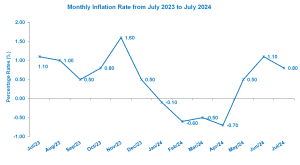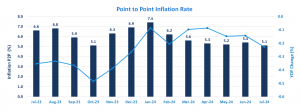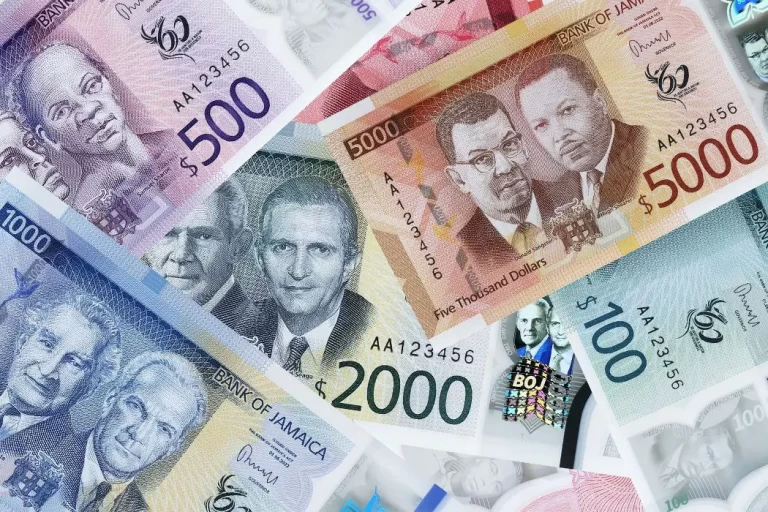August 19, 2024
The Statistical Institute of Jamaica (STATIN) reported that for July 2024, the point-to-point inflation rate was +5.1%; 0.3 percentage points lower than the 5.4% recorded for June 2023 to June 2024. Compared to June 2024, The All-Jamaica Consumer Price Index (CPI) for July 2024 increased by 0.8%.
The main driver of the monthly increase (0.8%) was a 1.9% increase in the index of the ‘food and Non-Alcoholic Beverages’ division, influenced mainly by continued increase in the prices of some agricultural produce, as such, the index for the class ‘Vegetables, tubers, plantains, cooking bananas and pulses’ rose by 7.4%. Additionally, a 0.4% increase in the index for the ‘Transport’ division contributed to the rise in the inflation rate, due to higher petrol prices and the increased toll rates for the East-West leg of Highway 2000.
The movement in the point-to-point inflation rate to 5.1% as at July 2024, was primarily influenced by increases in the following divisions: ‘Food and Non-Alcoholic Beverages’ (3.5%), ‘Transport’ (11.5%) and ‘Housing, Water, Electricity, Gas and Other Fuels’ (5.0%).
The rise in the index for the ‘Food and Non-Alcoholic Beverages’ division was driven by a 3.4% increase in the ‘Food’ group. Key contributors to this increase were higher prices for oranges, ripe bananas, pineapples, and dried coconut, which significantly affected the ‘Fruits and Nuts’ class (12.4%). Additionally, the ‘Cereals and Cereal Products’ class (4.0%) saw an upward trend largely due to increased prices for rice, bread, and other bakery products.
The ‘Transport’ division experienced a notable increase, primarily due to a 15.3% increase in the index for ‘Passenger Transport Services.’ This was largely the result of a significant 19% hike in fares for route and hackney carriage taxis implemented on October 15, 2023, as well as the Jamaica Urban Transit Company (JUTC) fare restructuring which took effect on May 13,2024.
In the ‘Housing, Water, Electricity, Gas and Other Fuels’ division, the index rise was mainly due to a 5.6% increase in the ‘Electricity, Gas and Other Fuels’ group and a 4.8% increase for the group ‘Imputed Rentals for Housing’. These increases were chiefly driven by higher rental and electricity rates.
MAJOR CPI DIVISION MOVEMENTS
There was a 1.9% increase in the index for the ‘Food and Non-Alcoholic Beverages’ division, driven by a 2.0% rise in the ‘Food’ group and a 0.3% increase in the ‘Non-Alcoholic Beverages’ group. The increase in the ‘Food’ group was largely due to a 7.4% surge in the ‘Vegetables, Tubers, Plantains, Cooking Bananas, and Pulses’ class, attributed to higher prices for agricultural produce such as yellow yam, tomato, carrot, and cabbage. Additionally, the class ‘Ready-made food and other food products’ rose by 2.8%, influenced by higher prices for escallion. Within the ‘Non-Alcoholic Beverages’ group, all classes increased, with fruit juices, teas, and carbonated beverages contributing to the rises in the ‘Fruit and Vegetable Juices’ class by 0.2%, and in the ‘Coffee, Tea, Cocoa’ and ‘Water, Soft Drinks, and Other Non-Alcoholic Beverages’ classes by 0.3% each.
The point-to-point inflation rate for this division was 3.5%.
The index for the ‘Alcoholic Beverages, Tobacco and Narcotics’ division increased by 0.8%, driven primarily by a 0.8% rise in the ‘Alcoholic Beverages’ group due to higher prices for rums, beer, and wines. Additionally, the ‘Tobacco’ group index increased by 0.7% due to higher cigarette prices..
The point-to-point inflation rate for this division was 6.8%.
The index for the ‘Clothing and Footwear’ division increased by 0.3%, driven mainly by the ‘Clothing’ group rising 0.3% due to higher prices for some clothing material.
The point-to-point inflation rate for this division was 3.3%.
The index for the ‘Housing, Water, Electricity, Gas and Other Fuels’ division increased by 0.1%. This was primarily due to a 1.5% rise in the ‘Water Supply and Miscellaneous Services Relating to the Dwelling’ group, driven by higher water and sewage rates. The ‘Maintenance, Repair and Security of the Dwelling’ group also saw a slight increase of 0.1%. However, the overall increase in the division was tempered by a 0.1% decline in the ‘Electricity, Gas and Other Fuels’ group, due to lower electricity rates.
The point-to-point inflation rate for this division was 5.0%.
The index for the ‘Furnishings, Household Equipment and Routine Household Maintenance’ division rose by 0.1%. This increase was reflected across most groups within the division, with ‘Furniture, Furnishings and Loose Carpets’ rising by 0.1%, ‘Household Textiles’ by 0.1%, ‘Household Appliances’ by 0.2%, and ‘Goods and Services for Routine Household Maintenance’ by 0.1%.
The point-to-point inflation rate was 5.3%.
The index for the ‘Health’ increased by 0.2%, primarily driven by a 0.3% rise in the ‘Medicines and Health Products’ group due to higher prices for some prescription drugs. Additionally, higher laboratory testing fees contributed to a 0.1% increase in the ‘Other Health Services’ group.
The point-to-point inflation rate was 4.3%.
There was a 0.4% increase in the index for the ‘Transport’ division. The main factors that impacted this were higher petrol prices and increased toll rates for the East-West leg of Highway 2000.
The point-to-point inflation rate was 11.5%.
There was a 1.3% decline in the ‘Information and Communication’ division, due to rates adjustment for telecommunication services.
The point-to-point inflation rate was 3.9%.
The index for ‘Recreation, Sport and Culture’ increased by 0.5%. This was influenced primarily by higher prices for school books and stationery items.
The point-to-point inflation rate was 4.8%.
The index for ‘Restaurants and Accommodation Services’ increased by 0.1%. This was influenced primarily by higher prices for accommodation services.
The point-to-point inflation rate was 3.7%.
The index for the ‘Personal Care, Social Protection and Miscellaneous Good and Services’ division increased by 0.2%. This was mainly influenced by higher prices for some personal care products and services.
The point-to-point inflation rate was 3.7%.
Individual divisions saw the following changes:
- Food and Non-Alcoholic Beverages: (+1.9%)
- Alcoholic Beverages, Tobacco and Narcotics: (+0.8%)
- Clothing and Footwear: (+0.3%)
- Housing, Water, Electricity, Gas and Other Fuels: (+0.1%)
- Furnishing, Household Equipment and Routine Household Maintenance: (+0.1%)
- Health: (+0.2%)
- Transport: (+0.4%)
- Information and Communication: (-1.3%)
- Recreation, Sport, and Culture: (+0.5%)
- Education: (0.0%)
- Restaurants and Accommodation Services: (+0.1%)
- Insurance and Financial Services (0.0%)
- Personal Care, Social Protection and Miscellaneous Goods and Services: (+0.2%)


Disclaimer:
Analyst Certification – The views expressed in this research report accurately reflect the personal views of Mayberry Investments Limited Research Department about those issuer (s) or securities as at the date of this report. Each research analyst (s) also certify that no part of their compensation was, is, or will be, directly or indirectly, related to the specific recommendation (s) or view (s) expressed by that research analyst in this research report.
Company Disclosure – The information contained herein has been obtained from sources believed to be reliable, however its accuracy and completeness cannot be guaranteed. You are hereby notified that any disclosure, copying, distribution or taking any action in reliance on the contents of this information is strictly prohibited and may be unlawful. Mayberry may affect transactions or have positions in securities mentioned herein. In addition, employees of Mayberry may have positions and effect transactions in the securities mentioned herein.





